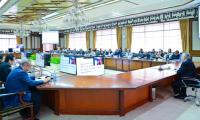The downpour on Sunday caused relatively less damage in Karachi because the weekend kept most people at home and traffic on the roads sparse. Had it been a weekday, the spell of rain would have been this year’s worst in terms of its potentially devastating effects on the city.
Since the Met Office has forecast more rain for Monday, people should brace themselves because the worst may be yet to come, especially because the Sindh and local governments have once again miserably failed to get the storm water drains cleaned in time.
It wasn’t until July 2 that the Karachi Metropolitan Corporation (KMC) and the six district municipal corporations (DMCs) got around to start cleaning the city’s nullahs — after holding several news conferences against the provincial government and demanding funds.
Most of the filth taken out of the drains in District Central was already on the footpaths and roads. After it rained heavily, the sludge was strewn across the roads and then pushed back into the nullahs due to the water pressure.
Soon after the third spell of this year’s monsoon showers started in the city on Sunday, the major thoroughfares, such as Sharea Faisal, University Road, Sher Shah Suri Road and Shahrah-e-Pakistan, were inundated with rainwater.
The storm water drains overflowed, and around 80 per cent of the metropolis was deprived of electricity as more than 550 feeders reportedly tripped. Due to a power breakdown at the Karachi Water & Sewerage Board’s (KWSB) main pumping station at Gharo, water supply to the city was also suspended.
Localities like Malir, Shah Faisal Colony, Defence View, Akhtar Colony, Manzoor Colony, Gulistan-e-Jauhar, Gulshan-e-Iqbal, North Karachi, Nazimabad, North Nazimabad, Orangi Town, Liaquatabad, PIB Colony and Scheme-33 as well as several other areas of the city faced power failures that lasted late into the night.
K-Electric, however, made the assurance that the restoration of power supply was being carried out swiftly. The company also said that electricity supply to certain areas could not be restored because of flooded roads.
Moreover, the Thado Dam in Gadap Town started filling with water as it rained heavily in its catchment areas. Until 6pm the dam had stored some 20 feet of water.
All the roads and passages in its surroundings were flooded with the gushing rainwater. There are three weirs and 10 small dams on the Malir River.
Flooding
Nagan Chowrangi in District Central disappeared completely due to the downpour because the major storm water drain beneath it overflowed. This wasn’t the first time that it had happened.
New drains were built at the intersection during the construction of the Green Line busway project, but they also failed to carry the rainwater. Even the track of Green Line was inundated with water at the Chowrangi.
Just before Nagan Chowrangi, Shadman Town was also flooded with rainwater, while the Central DMC’s tractor demolished the walls of the storm water drains so that water could be drained. At UP Morr, roads and footpaths were broken at several points so that the water could get passage for drainage.
“This is absolutely poor planning!” said UP Morr resident Waqas Ali. “Every year the authorities have to break the banks of these drains, but they don’t find a permanent solution.”
The Gujjar Nullah — where the authorities annually drain millions of rupees for its cleaning but keep failing to sustainably get it cleaned — once again overflowed and flooded the residential areas constructed on its bank. In the nearby Block-5 of the Federal B Area, rainwater flowed into the houses.
In Gulistan-e-Jauhar Block-12, the cars parked in the streets drowned in rainwater. The knee-deep water at Jauhar Chowrangi was drained at around 5pm. At Nipa and Samama, the drains overflowed and submerged University Road. At Sharea Faisal, the Drigh Road underpass was partially closed for traffic after the downpour.
Rainwater also accumulated in the FTC area at Sharea Faisal and Gora Qabristan, on Aiwan-e-Sadar Road, and at Pakistan Chowk and Tibet Centre. Knee-deep water could also be seen right in front of the KMC’s head office on MA Jinnah Road.
In the absence of a drainage system, water entered with pressure in several residential societies in Scheme-33. Model Colony and the PECHS were among the worst-hit localities of the city. DHA, however, was less affected because most of its drains were cleaned and had the capacity to take rainwater. Drainage
Karachi Mayor Wasim Akhtar visited different areas to review the measures for draining out rainwater. He also talked to people at the Chaman and Saddar nullahs, and seemed satisfied with the city’s situation. Akhtar claimed that had the KMC not removed encroachments from the Gujjar, Saddar, Soldier Bazaar, Mehmoodabad, PECHS and other storm water drains, the situation might have been very different. “We cleaned these nullahs properly in 2018 and that’s why they are still draining out rainwater.”
He said he had requested the Sindh government to expedite the drains’ cleaning and also asked for finding a permanent solution. He added that the traffic flow at all the KMC’s underpasses was normal, and staff was deployed to drain water timely. “All KMC departments are on high alert.”
KWSB Managing Director Khalid Sheikh also visited different areas of the city and directed his staff to deploy more machinery at Nagan Chowrangi, Sharea Faisal and Nipa Chowrangi.
A press statement said the water board had taken all measures for draining rainwater, and their jetting machines, rodding machines, dewatering pumps and sewer cleaners were deployed in every low-lying area of the city.
The MD visited the PECHS, Drigh Road, the Karsaz area, II Chundrigar Road, Burns Road, Pakistan Chowk, Club Road, Gulshan-e-Iqbal, the PIDC area, North Karachi and other parts of the city.
It is pertinent to mention here that most of the KWSB’s manholes were uncovered in several areas of the city, while people filled them with sticks or placed bricks around them to warn commuters and other passers-by.
Electricity
Due to torrential rains that were followed by urban flooding, KE temporarily suspended power supply to the low-lying areas of the Orangi, Korangi, Defence, Baldia, Gulshan and Bin Qasim localities as well as the areas with high incidences of illegal connections in the interest of public safety.
A press statement said the power company’s teams remained engaged in restoring power to the affected areas as soon and as safely as possible in view of the rainwater accumulated due to drainage challenges. The KE management is also coordinating with the city administration to drain the water necessary to restore power.
“KE teams remained fully alert following the prediction of rain and responded swiftly to restore electricity in the affected areas,” said the spokesperson for the company.
“While waterlogging in low-lying and other areas caused difficulty in the restoration work, power supply to strategic installations, including key hospitals, KWSB pumping stations and the airport, was ensured and the teams responded swiftly in case of any interruptions.”
KE expressed regret over the inconvenience caused to its customers due to the weather, and advised staying away from broken wires, electric poles and transformers, especially during rainy and windy weather, and avoiding the use of illegal power connections.
Vigilance
Karachi Commissioner Iftikhar Shallwani directed all the local government bodies and deputy commissioners to remain vigilant during rainfall. A press statement said he monitored the rain-related operations across the city.
The DCs and assistant commissioners kept surveying different streets of the city and kept the commissioner informed about the drainage situation in their respective jurisdictions.
Shallwani also directed KE to carry out their duties to keep people safe from the power company’s installations. He also appealed to the people to keep a safe distance from such installations.







